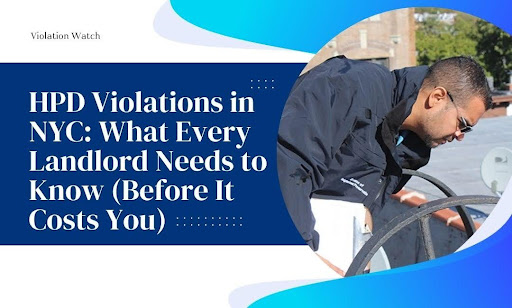That $1,000 HPD violation sitting in your mailbox? It’s just the beginning. NYC landlords lose thousands of dollars annually to preventable housing violations—money that should be building your wealth, not draining it.
HPD violations aren’t just paperwork headaches. They’re ticking time bombs that can destroy your property value, block refinancing, and even land you in court. Yet most landlords don’t realize they’re breaking the rules until it’s too late.
Here’s what we’ll cover:
- The three HPD violation classes, and which ones can shut down your building
- Your exact legal responsibilities as an NYC landlord (and the ones everyone gets wrong)
- The real financial damage of ignoring violations—beyond the fines
- Step-by-step violation resolution strategies that actually work
- Prevention tactics that keep inspectors happy and violations at zero
- How to handle emergency violations without panic or overpaying contractors
If you want to stay ahead of the HPD violations in NYC, keep reading!
Understanding HPD Violation Classes
HPD violations come in three distinct classes, and knowing the difference can save your building from shutdown. Each class carries different deadlines, penalties, and consequences that directly impact your bottom line.
- Class A violations are considered “non-hazardous.” You might see these for minor maintenance issues like small plaster cracks or missing outlet covers. You get 90 days to fix these, and while they won’t immediately threaten your tenants, they still matter.
- Class B violations step things up. These are “hazardous” conditions that need fixing within 30 days. Think broken door locks, inadequate lighting in hallways, or malfunctioning smoke detectors. Ignore these, and you’re looking at serious legal trouble.
- Class C violations are where things get critical. These “immediately hazardous” conditions require action within 24 hours. We’re talking about:
- Lead-based paint hazards in apartments with children under 6
- No heat or hot water violations during required seasons
- Severe mold infestations affecting habitability
- Broken windows in the winter months
- Gas leaks or carbon monoxide risks
- Rodent or bedbug infestations at dangerous levels
Here’s what most landlords miss: multiple Class B violations can escalate your entire building to emergency status. Three or more hazardous violations? HPD can initiate an emergency repair program, take control of fixes, and bill you triple the normal cost.
Class C violations trigger immediate tenant rights. Your tenants can legally withhold rent, call 311 repeatedly (generating more violations), and even pursue housing court action. Worse? These violations appear on public records, scaring away potential buyers and making refinancing nearly impossible.
The classification system isn’t random. HPD inspectors follow strict guidelines based on the Housing Maintenance Code. What seems like a minor issue to you might qualify as hazardous under city standards. That “small” water leak becomes a Class B mold risk. Those “cosmetic” wall cracks near windows? Potential lead paint exposure.
Landlord Responsibilities Under NYC Law in Housing Court

Your legal obligations as an NYC landlord go way beyond collecting rent and fixing leaks. The New York City Department of Housing Preservation and Development (HPD) spells out dozens of requirements—and missing even one opens you up to violations.
The basics everyone knows:
- Provide heat (68°F minimum during the day, 62°F at night) from October 1 to May 31
- Maintain hot water 24/7 at 120°F minimum
- Keep common areas clean and well-lit
- Ensure working smoke and carbon monoxide detectors
The requirements that catch landlords off guard
You must inspect for lead paint annually in pre-1960 buildings if children under 6 live there. Not just inspect—you need written documentation proving you checked. Missing paperwork alone triggers violations, even if no lead exists on the premises.
Window guards become mandatory when children under 11 occupy the unit. You can’t wait for tenants to request them. The local law requires you to survey tenants annually about children and install guards proactively.
Here’s a requirement that bankrupts unprepared landlords: bedbug disclosure forms. You must notify tenants with a one-year bedbug infestation history for their unit and the entire building. Forget this form? That’s an automatic violation with fines starting at $300.
Documentation requirements that trip up even experienced landlords:
| Required Record | Retention Period | Violation Fine |
| Annual property registration | Permanent | $300-$500 |
| Lead paint inspections | 10 years | $250-$2,000 |
| Exterminator visits | 4 years | $300+ |
| Boiler inspections | 5 years | $500-$1,000 |
| Tenant complaint responses | 7 years | Varies |
You’re also responsible for tenant-caused issues if you don’t address them quickly. That tenant who never reports the bathroom leak? Once HPD finds mold, it’s your violation—not theirs. The law expects you to conduct regular inspections and catch problems early.
Self-certification adds another layer. For certain violations, you can avoid reinspection fees by certifying completion yourself. But certify a correction falsely? You’re facing criminal charges, not just fines. HPD conducts random audits, and fraudulent certifications mean permanent marks on your record.
Property owners and their managing agent share equal responsibility for compliance. Even if you’ve delegated everything to a management company, you remain liable for violations. Smart owners verify their managers understand all HPD requirements and maintain proper supporting documentation.
The True Cost of HPD Violations
Forget the initial fine—that’s just the entrance fee to a much more expensive game. HPD violations create a financial cascade that devastates unprepared landlords. Failure to comply leads to escalating penalties beyond the initial financial penalty.
Immediate costs you expect:
- Class A violations: $50-$110 per violation
- Class B violations: $250-$500 per violation
- Class C violations: $250-$1,000 per violation
The Hidden Expenses that Destroy Budgets
Emergency repair programs hit hardest. When HPD takes over repairs, you pay their contractors at premium rates—often 200-300% above market price. That $500 plumbing fix becomes a $1,500 city-managed repair, plus administrative fees.
Legal costs mount quickly. Each violation can trigger tenant lawsuits, especially for habitability issues. Defense attorneys charge $300-$500 hourly, and cases drag on for months. One Class C violation easily generates $10,000+ in legal fees. HP proceeding cases in housing court add another layer of expense when tenants pursue legal action for non-compliance.
Your financing disappears overnight. Banks won’t touch properties with open violations. Need to refinance? Impossible. Want to sell? Buyers demand massive price reductions or walk away entirely. We’ve seen properties lose 15-20% of their value due to violation histories.
The Revenue Destruction Timeline
- Month 1: Tenants gain legal right to withhold rent for unresolved hazardous violations
- Month 2: Additional violations accumulate from repeated 311 calls
- Month 3: Housing court proceedings begin, legal fees multiply
- Month 6: Credit reports show judgments, financing options vanish
- Year 1: Property blacklisted, insurance premiums increase 40%+
Insurance companies treat violations as risk indicators. Multiple violations? Your premiums skyrocket. Some insurers simply cancel policies, forcing you into expensive surplus lines coverage at 3x normal rates.
Long-term Market Impact
Properties with violation histories sell for significantly less:
- 1-5 violations: 5-8% price reduction
- 6-15 violations: 10-15% price reduction
- 15+ violations: 20%+ price reduction or no viable buyers
Professional management companies won’t take on buildings with extensive violation records. You’re stuck self-managing or hiring subpar companies that perpetuate the violation cycle. Noncompliance creates a reputation that follows you throughout NYC’s real estate community.
Tax implications compound the damage. Emergency repairs often exceed normal deduction limits, and rushed work rarely qualifies for energy efficiency credits. You pay more while claiming less.
Step-by-Step Violation Resolution Strategies
Getting that violation notice feels overwhelming, but a systematic approach turns chaos into manageable steps. Here’s the proven process that works every time, including how to handle inspection fees and ensure violations get corrected properly.
- Document everything immediately: Photograph the violation area from multiple angles before starting any work. Take date-stamped photos showing the condition, surrounding areas, and any contributing factors. This protects you from false claims and proves compliance later.
- Decode the violation notice: Read past the legal jargon. Find these critical details:
- Exact violation code and class
- Specific location within your property
- Required correction deadline
- Reinspection requirements
The Department of Housing Preservation and Development provides detailed information about each violation code on its website. Understanding the specific requirements helps you address the root cause, not just symptoms.
- Create your action timeline
| Violation Class | Response Deadline | First Action Required |
| Class C | Within 24 hours | Emergency repair + notify HPD |
| Class B | Within 72 hours | Get contractor quotes |
| Class A | Within 1 week | Schedule repairs |
Hire qualified contractors: Skip the handyman for HPD violations. You need licensed contractors who understand city codes. Get written estimates specifying:- HPD code compliance
- Completion timeline
- Warranty terms
- Proper permits included
For lead-related violations, contractors must follow RRP (Renovation, Repair, and Painting) protocols. For buildings with self-closing door requirements, use contractors familiar with fire safety codes.
- Maintain tenant communication: Send written notices about repair schedules. Document access attempts if tenants don’t cooperate. HPD won’t excuse violations because tenants refused entry—you need proof you tried. Smart communication tactics include:
- Text and email simultaneously for paper trails
- Give 48-hour minimum notice
- Offer multiple time slots
- Use certified mail for non-responsive tenants
- Execute repairs properly: Don’t just fix the visible problem. Address root causes or violations. That bathroom leak needs more than new drywall—fix the pipe, treat the mold, then repair the walls.
- Document completion thoroughly: Take after photos matching your before shots. Keep:
- Contractor invoices and licenses
- Work permits
- Product receipts (especially for lead-safe materials)
- Signed tenant acknowledgments
- File your certification: Submit HPD compliance certification within the required timeframes. Include all documentation. Pay any associated fees immediately—delays trigger additional penalties.
- Confirm clearance: Check HPD’s online system two weeks after certification. Violations sometimes remain active due to processing errors. Follow up immediately if the status hasn’t been updated. Consider consulting legal counsel if violations persist despite proper correction.
Regular maintenance prevents repeat violations. Schedule quarterly walk-throughs. Create standardized checklists covering common violation triggers. Fix small issues before they become HPD problems.
Stay informed about code changes. Housing codes update frequently. Subscribe to HPD bulletins. Join landlord associations for regulatory updates. What passed inspection last year might violate new standards today. This systematic approach resolves violations efficiently while building your defense against future issues.
Prevention Tactics That Keep Violations and HPD Inspections at Zero

Smart landlords prevent violations rather than scramble to fix them. These proven tactics keep Housing Preservation and Development HPD inspectors satisfied and your properties violation-free.
Create detailed maintenance schedules
Map out every system in your building with specific inspection dates:
- Monthly checks: Smoke detectors, emergency lighting, common area cleanliness
- Quarterly reviews: Pest control, HVAC systems, plumbing fixtures
- Annual inspections: Lead paint assessments, window guards, boiler certifications
Document each inspection with photos and signatures. This paper trail proves proactive management during any HPD review.
Build your rapid-response team
Pre-qualify contractors for common issues:
- 24/7 emergency plumber
- Licensed electrician
- Lead-safe certified painter
- Registered pest control service
Having vetted professionals on speed dial means fixing problems before tenants call 311.
Master tenant screening and education
Quality tenants report issues early, preventing violation escalation. During lease signing:
- Provide written maintenance request procedures
- Explain their responsibility to report problems
- Share emergency contact information
- Review the consequences of unreported issues
Automate your violation tracking
Manual tracking fails when managing multiple properties. ViolationWatch transforms violation management through intelligent automation. The platform monitors all your properties across every NYC agency—DOB, HPD, ECB, FDNY, and more—sending instant alerts when new violations appear.
Instead of checking multiple city websites daily, you get real-time notifications delivered to your inbox. The system tracks violation deadlines, stores compliance documents, and generates reports showing your resolution progress. For portfolio owners, the dashboard displays all properties on one screen, highlighting those that need immediate attention.
ViolationWatch includes expert guidance for complex violations, connecting you with compliance professionals who understand NYC’s intricate regulations. This combination of technology and expertise prevents costly mistakes that trigger additional violations.
Conduct pre-emptive self-inspections
Use HPD’s inspection checklist for monthly property reviews. Look for:
- Paint conditions in pre-1960 buildings
- Water damage indicators
- Pest entry points
- Safety hazard developments
Fix everything before it reaches the violation threshold.
Maintain sterling documentation
Create digital folders for each property containing:
- All permits and certificates
- Inspection reports with photos
- Repair invoices and warranties
- Tenant communication logs
- Code compliance records
Cloud storage ensures access anywhere, anytime—critical during surprise inspections.
Build positive tenant relationships
Happy tenants rarely call 311. Respond to maintenance requests within 24 hours. Address concerns professionally. Small gestures like seasonal HVAC filter replacements show you care about their comfort.
These prevention strategies transform violation management from reactive firefighting to proactive property care. The investment in prevention pays back tenfold through avoided fines, legal fees, and property value preservation.
Handling Emergency Violations Without the Panic

Class C violations demand immediate action, but rushing leads to overpaying and poor fixes. Here’s how to handle emergencies strategically.
The first hour protocol is to stop the immediate danger first. No heat in winter? Provide space heaters within 2 hours. Document this temporary fix with photos and tenant signatures—it shows good faith while you arrange permanent repairs.
Contact your pre-qualified emergency contractors immediately. Avoid calling random services from Google—desperate landlords pay 3x normal rates. Your established relationships get priority scheduling at fair prices.
Negotiate from strength, not desperation. Emergency doesn’t mean accepting any price. Get phone quotes from 2-3 contractors, even for urgent work. Mention you’re comparing prices—contractors often lower quotes by 20-30% to secure immediate work.
Red flags that signal overcharging:
- Demanding full payment up front
- Quoting without seeing the problem
- Pushing unnecessary “upgrades”
- No written estimate provided
Document everything for HPD: While contractors work, photograph:
- The emergency condition
- Repair work in progress
- Completed fixes
- Happy tenants (if willing)
Email these photos to yourself for timestamp verification. HPD accepts documented good-faith efforts even if full repair takes days.
Smart cost controls:
- Request only code-minimum fixes initially
- Skip cosmetic work during emergencies
- Verify contractor licenses before work begins
- Pay with credit cards for dispute protection
The 24-hour gameplan:
- Hours 1-3: Mitigate danger, call contractors, document conditions
- Hours 4-8: Get estimates, schedule repair, notify affected tenants
- Hours 9-16: Execute repairs, maintain tenant communication
- Hours 17-24: Document completion, file HPD notifications
Post-emergency steps:
- Review what caused the emergency.
- Update maintenance schedules to prevent recurrence.
- Add backup systems where feasible—secondary water heaters, backup heating systems, or emergency lighting prevent future Class C violations.
Keep emergency repair receipts for tax deductions. Document how you’ve improved systems to prevent repeats—this helps during any follow-up inspections.
Your Violation-Free Future Starts Now
You’ve got the blueprint—HPD violation classes, your legal responsibilities, the true costs, and proven resolution strategies. No more surprise fines or emergency scrambles. Knowledge transforms violations from profit-killers into manageable tasks.
Key takeaways to protect your investment:
- Class C violations need action within 24 hours, but smart protocols prevent costly panic-driven decisions
- Documentation beats disputes every time—photograph everything, keep digital records, and maintain clear tenant communication logs
- Prevention costs pennies compared to violations—scheduled maintenance and automated tracking save thousands annually
- Emergency contractors love desperate landlords—pre-qualified teams and calm negotiation cut costs by 30%
Ready to put this knowledge into action? ViolationWatch automates everything we’ve covered—tracking, alerts, deadlines, and documentation—so you focus on growing your portfolio, not chasing paperwork. Start your free trial today.

